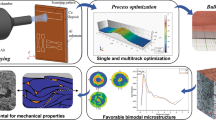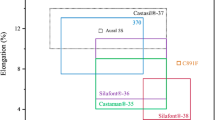Abstract
Aluminium is one of the most experimented metals in the WAAM field owing to a wide range of applications in the automotive sector. Due to concerns over reduction of strength, elimination of porosity from wire arc additive manufactured aluminium is one of the major challenges. In line with this, the current investigation presents findings on hydrogen dissolution in solid aluminium and hydrogen consumed to form porosity along with its distribution as a function of heat inputs and interlayer temperatures in a WAAM 5183 aluminium alloy. Two varieties of WAAM, pulsed metal inert gas (MIG) and cold metal transfer (CMT), were explored. Samples made with pulsed metal inert gas (pulsed-MIG) process picked up more hydrogen compared to samples produced by cold metal transfer technique. Correspondingly, pulsed-MIG samples showed increased number of pores and volume fraction of porosity than samples manufactured using the cold metal transfer (CMT) technique for different heat input and interlayer temperature conditions. However, CMT samples exhibited higher amount of dissolved hydrogen in solid solution compared to pulsed-MIG process. In addition, heat input, interlayer temperature, and interlayer dwell time also played a key role in pore formation and distribution in WAAM-produced aluminium 5183 alloy.

















Similar content being viewed by others
References
Derekar KS (2018) A review of wire arc additive manufacturing and advances in wire arc additive manufacturing of aluminium. Mater Sci Technol (United Kingdom) 34:895–916. https://doi.org/10.1080/02670836.2018.1455012
Martina F, Mehnen J, Williams SW, Colegrove P, Wang F (2012) Investigation of the benefits of plasma deposition for the additive layer manufacture of Ti-6Al-4V. J Mater Process Technol 212:1377–1386. https://doi.org/10.1016/j.jmatprotec.2012.02.002
Williams SW, Martina F, Addison AC, Ding J, Pardal G, Colegrove P (2016) Wire + arc additive manufacturing. Mater Sci Technol 32:641–647. https://doi.org/10.1179/1743284715Y.0000000073
Yang D, He C, Zhang G (2016) Forming characteristics of thin-wall steel parts by double electrode GMAW based additive manufacturing. J Mater Process Technol 227:153–160. https://doi.org/10.1016/j.jmatprotec.2015.08.021
Zhang C, Li Y, Gao M, Zeng X (2018) Wire arc additive manufacturing of Al-6Mg alloy using variable polarity cold metal transfer arc as power source. Mater Sci Eng A 711:415–423. https://doi.org/10.1016/j.msea.2017.11.084
Fang X, Zhang L, Chen G, Dang X, Huang K, Wang L, Lu B (2018) Correlations between microstructure characteristics and mechanical properties in 5183 aluminium alloy fabricated by wire-arc additive manufacturing with different arc modes. Materials (Basel) 11. https://doi.org/10.3390/ma11112075
Gu J, Wang X, Bai J, Ding J, Williams S, Zhai Y, Liu K (2018) Deformation microstructures and strengthening mechanisms for the wire+arc additively manufactured Al-Mg4.5Mn alloy with inter-layer rolling. Mater Sci Eng A 712:292–301. https://doi.org/10.1016/j.msea.2017.11.113
Gu J, Ding J, Williams SW, Gu H, Bai J, Zhai Y, Ma P (2016) The strengthening effect of inter-layer cold working and post-deposition heat treatment on the additively manufactured Al-6.3Cu alloy. Mater Sci Eng A 651:18–26. https://doi.org/10.1016/j.msea.2015.10.101
Gu J, Cong B, Ding J, Williams SW, Zhai Y (2014) Wire+arc additive manufacturing of Aluminium, in: Proc 25th Annu Int solid free Fabr Symp, Austin, Texas, pp 4–6
Qi Z, Cong B, Qi B, Sun H, Zhao G, Ding J (2018) Microstructure and mechanical properties of double-wire + arc additively manufactured Al-Cu-Mg alloys. J Mater Process Technol 255:347–353. https://doi.org/10.1016/j.jmatprotec.2017.12.019
Gu J, Ding J, Williams SW, Gu H, Ma P, Zhai Y (2016) The effect of inter-layer cold working and post-deposition heat treatment on porosity in additively manufactured aluminum alloys. J Mater Process Technol 230:26–34. https://doi.org/10.1016/j.jmatprotec.2015.11.006
Cong B, Ding J, Williams S (2014) Effect of arc mode in cold metal transfer process on porosity of additively manufactured Al-6.3%Cu alloy. Int J Adv Manuf Technol 76:1593–1606. https://doi.org/10.1007/s00170-014-6346-x
Horgar A, Fostervoll H, Nyhus B, Ren X, Eriksson M, Akselsen OM (2018) Additive manufacturing using WAAM with AA5183 wire. J Mater Process Technol 259:68–74. https://doi.org/10.1016/j.jmatprotec.2018.04.014
Yousefian P, Tiryakioğlu M (2018) Pore formation during solidification of aluminum: reconciliation of experimental observations, modeling assumptions, and classical nucleation theory. Metall Mater Trans A Phys Metall Mater Sci 49:563–575. https://doi.org/10.1007/s11661-017-4438-6
Mathers G (2002) The welding of aluminium and its alloys. Woodhead publishing limited, Cambridge England. https://doi.org/10.1533/9781855737631.1
Devletian J, Wood W (1983) Factors affecting porosity in aluminum welds - a review. Weld Res Counc 290:1–18
Geng H, Li J, Xiong J, Lin X (2017) Optimisation of interpass temperature and heat input for wire and arc additive manufacturing 5A06 aluminium alloy. Sci Technol Weld Join 22:472–483. https://doi.org/10.1080/13621718.2016.1259031
Ryan EM, Sabin TJ, Watts JF, Whiting MJ (2018) The influence of build parameters and wire batch on porosity of wire and arc additive manufactured aluminium alloy 2319. J Mater Process Technol 262:577–584. https://doi.org/10.1016/j.jmatprotec.2018.07.030
Gu JL, Ding JL, Cong BQ, Bai J, Gu HM, Williams SW, Zhai YC (2014) The influence of wire properties on the quality and performance of wire+arc additive manufactured aluminium parts. Adv Mater Res 1081:210–214. https://doi.org/10.4028/www.scientific.net/AMR.1081.210
Cong B, Qi Z, Qi B, Sun H, Zhao G, Ding J (2017) A comparative study of additively manufactured thin wall and block structure with Al-6.3%Cu alloy using cold metal transfer process. Appl Sci 7:275. https://doi.org/10.3390/app7030275
Kou S (2003) Metallurgy Second Edition Welding Metallurgy. https://doi.org/10.1016/j.theochem.2007.07.017
Cong B, Ouyang R, Qi B, Ding J (2016) Influence of cold metal transfer process and its heat input on weld bead geometry and porosity of aluminum-copper alloy welds. Rare Metal Mater Eng 45:606–611. https://doi.org/10.1016/S1875-5372(16)30080-7
Gao YX, Yi JZ, Lee PD, Lindley TC (2004) The effect of porosity on the fatigue life of cast aluminium-silicon alloys. Fatigue Fract Eng Mater Struct 27:559–570. https://doi.org/10.1111/j.1460-2695.2004.00780.x
Wu B, Ding D, Pan Z, Cuiuri D, Li H, Han J, Fei Z (2017) Effects of heat accumulation on the arc characteristics and metal transfer behavior in wire arc additive manufacturing of Ti6Al4V. J Mater Process Technol 250:304–312. https://doi.org/10.1016/j.jmatprotec.2017.07.037
Xiong J, Lei Y, Li R (2017) Finite element analysis and experimental validation of thermal behavior for thin-walled parts in GMAW-based additive manufacturing with various substrate preheating temperatures. Appl Therm Eng 126:43–52. https://doi.org/10.1016/j.applthermaleng.2017.07.168
Xiong J, Li R, Lei Y, Chen H (2018) Heat propagation of circular thin-walled parts fabricated in additive manufacturing using gas metal arc welding. J Mater Process Technol 251:12–19. https://doi.org/10.1016/j.jmatprotec.2017.08.007
Grigorenko G (1970) Formation of pores in welds. Avtom Svarka 10:13–17
Hasegawa M (2014) Ellingham diagram. Elsevier Ltd. https://doi.org/10.1016/B978-0-08-096986-2.00032-1
Hashimoto E, Kino T (1983) Hydrogen diffusion in aluminium at high temperatures. J Phys F Met Phys 13:1157–1165. https://doi.org/10.1088/0305-4608/13/6/013
Wang P, Hu S, Shen J, Liang Y (2017) Characterization the contribution and limitation of the characteristic processing parameters in cold metal transfer deposition of an Al alloy. J Mater Process Technol 245:122–133. https://doi.org/10.1016/j.jmatprotec.2017.02.019
Chalmers B (1970) Principles of solidification. In: Appl Solid State Phys. Springer, Boston, pp 161–170. https://doi.org/10.1007/978-1-4684-1854-5_5
Llnderoth S (1988) Hydrogen diffusivity in aluminium. Philos Mag Lett 57:229–234. https://doi.org/10.1080/09500838808214712
Derekar K, Lawrence J, Melton G, Addison A, Zhang X, Xu L (2019) Influence of interpass temperature on wire arc additive manufacturing (WAAM) of aluminium alloy components. In: MATEC Web Conf, p 05001. https://doi.org/10.1051/matecconf/201926905001
Acknowledgements
Lloyd’s Register Foundation helps to protect life and property by supporting engineering-related education, public engagement and the application of research. The present work was enabled through, and undertaken at, the National Structural Integrity Research Centre (NSIRC), a postgraduate engineering facility for industry-led research into structural integrity establishment and managed by TWI through a network of both national and international Universities. The authors would like to acknowledge the support from Alan Clarke, Georgios Liaptsis and Rohit Kshirsagar.
Funding
This publication was made possible by the sponsorship and support of Lloyd’s Register foundation (Grant Number KD022017COV), Coventry University (Grant Number 7477993) and Kraken project, a Horizon 2020 project (Grant Number 723759) funded by European Commission.
Author information
Authors and Affiliations
Corresponding author
Ethics declarations
Conflict of interest
The authors declare that they have no conflict of interest.
Additional information
Publisher’s note
Springer Nature remains neutral with regard to jurisdictional claims in published maps and institutional affiliations.
Appendix
Appendix
Dissolved hydrogen calculations for sample C-LH-T2
- 1.
Total volume of the sample pore measurement by XCT scan = 1440 mm3
Mass of the sample considered can be calculated as
$$ {\displaystyle \begin{array}{c}\mathrm{Mass}=\mathrm{density}\times \mathrm{volume}\\ {}=2.7\times {10}^{-3}\ \left(\mathrm{g}/{\mathrm{mm}}^3\right)\times 1440\ {\mathrm{mm}}^3\\ {}=3.888\ \mathrm{g}\end{array}} $$ - 2.
Total volume of the pores found in 1440 mm3 (3.888 g) of samples volume = 0.44 mm3.
- 3.
Weight of the samples tested for dissolved hydrogen = 0.402 g
Thus, corresponding volume of the pores in samples of weight 0.402 g can be calculated as
-
4.
Total hydrogen detected after dissolved hydrogen test 0.834 ppm
ppm to ml conversion can be as follows:
Thus, 0.834 ppm are
Hence, 0.93408 ml of hydrogen per 100 g of metal.
- 5.
Weight of the samples for dissolved hydrogen test was 0.402 g.
Thus, total hydrogen for 0.402 g of metal can be calculated as
Hence, 0.402 g of tested samples showed 0.003755 ml (375.5 × 10−5 ml) of total detected dissolved hydrogen.
- 6.
From point (3), we know that 0.402 g of samples showed 0.04549 mm3 of pore volume. Here, we are assuming that all the pores are completely filled with hydrogen.
Therefore, converting pore volume from mm3 to ml, we get
Hence, in a sample of weight 0.402 g with 0.04549 mm3 of pore showed 4.549 × 10−5 ml of hydrogen.
- 7.
From point (5), we know that total hydrogen in sample was 375.5 × 10−5 ml.
From point (6), it was clear that hydrogen in the pore was 4.549 × 10−5 ml.
Thus, dissolved hydrogen ca ne calculated as
$$ {\displaystyle \begin{array}{c}=\left(375.5\hbox{--} 4.549\right)\times {10}^{-5}\\ {}=370.951\times {10}^{-5}\ \mathrm{ml}\end{array}} $$
Dissolved hydrogen in the sample was 0.00370951 ml (370.951 × 10 −5 ml).
- 8.
Percentage of dissolved hydrogen with respect to total hydrogen in sample
$$ {\displaystyle \begin{array}{c}=\left(370.951\times {10}^{-5}\right)/\left(375.5\times {10}^{-5}\right)\times 100\\ {}=98.78\%\end{array}} $$
Thus, samples C-HH-T2 showed 98.78% of dissolved hydrogen and 1.22% of hydrogen in pores.
Dissolved hydrogen values for other samples after following similar calculations are summarized in Table 11.
Rights and permissions
About this article
Cite this article
Derekar, K.S., Addison, A., Joshi, S.S. et al. Effect of pulsed metal inert gas (pulsed-MIG) and cold metal transfer (CMT) techniques on hydrogen dissolution in wire arc additive manufacturing (WAAM) of aluminium. Int J Adv Manuf Technol 107, 311–331 (2020). https://doi.org/10.1007/s00170-020-04946-2
Received:
Accepted:
Published:
Issue Date:
DOI: https://doi.org/10.1007/s00170-020-04946-2




